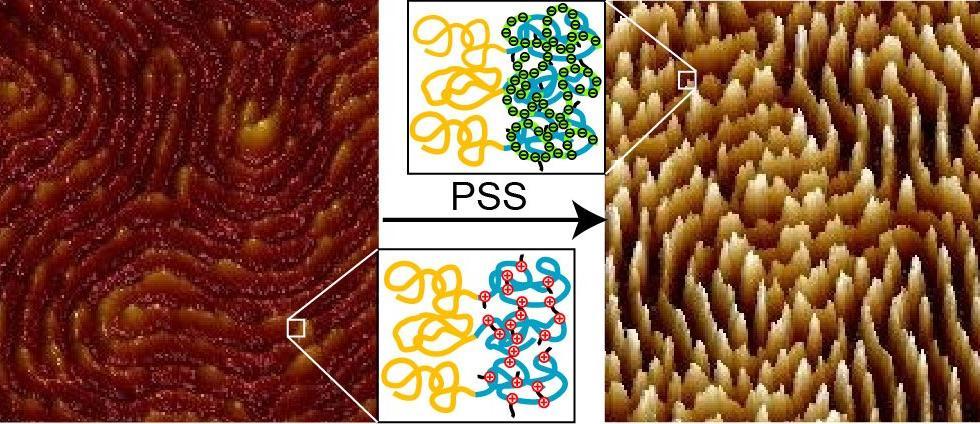Chandaluri, C. G. ; Pelossof, G. ; Tel-Vered, R. ; Shenhar, R. ; Willner, I. Block Copolymer Patterns as Templates for the Electrocatalyzed Deposition of Nanostructures on Electrodes and for the Generation of Surfaces of Controlled Wettability.
ACS Applied Materials & Interfaces 2016,
8 1440-1446.
AbstractITO electrodes modified with a nanopatterned film of polystyrene-block-poly(2-vinylpyridine), PS-b-P2VP, where the P2VP domains are quaternized with iodomethane, are used for selective deposition of redox-active materials. Electrochemical studies (cyclic voltammetry, Faradaic impedance measurements) indicate that the PS domains insulate the conductive surface toward redox labels in solution. In turn, the quaternized P2VP domains electrostatically attract negatively charged redox labels solubilized in the electrolyte solution, resulting in an effective electron transfer between the electrode and the redox label. This phenomenon is implemented for the selective deposition of the electroactive Prussian blue on the nanopatterned surface and for the electrochemical deposition of Au nanoparticles, modified with a monolayer of p-aminothiophenol/2-mercaptoethanesulfonic acid, on the quaternized P2VP domains. The patterned Prussian blue-modified surface enables controlling the wettability properties by the content of the electrochemically deposited Prussian blue. Controlled wettability is unattainable with the homopolymer-modified surface, attesting to the role of the nanopattern.

Oded, M. ; Müller, A. H. E. ; Shenhar, R. A block copolymer-templated construction approach for the creation of nano-patterned polyelectrolyte multilayers and nanoscale objects.
Soft Matter 2016,
12, 8098-8103.
AbstractA block copolymer-based assembly approach for the creation of nano-patterned polyelectrolyte multilayers over cm2-scale areas is presented. Up to 5 bi-layers were selectively assembled on top of specific nanodomains featuring different morphologies. The successful isolation of nanoscale objects corresponding in shape to the template features is also demonstrated. This methodology is applicable to different types of polyelectrolytes, and opens up a new dimension for layer-by-layer construction.
Oded, M. ; Kelly, S. T. ; Gilles, M. K. ; Müller, A. H. E. ; Shenhar, R. From dots to doughnuts: Two-dimensionally confined deposition of polyelectrolytes on block copolymer templates.
Polymer 2016,
107, 406-414.
AbstractThe combination of block copolymer templating with electrostatic self-assembly provides a simple and robust method for creating nano-patterned polyelectrolyte multilayers over large areas. The deposition of the first polyelectrolyte layer provides important insights on the initial stages of multilayer buildup. Here, we focus on two-dimensionally confined ``dots'' patterns afforded by block copolymer films featuring hexagonally-packed cylinders that are oriented normal to the substrate. Rendering the cylinder caps positively charged enables the selective deposition of negatively charged polyelectrolytes on them under salt-free conditions. The initially formed polyelectrolyte nanostructures adopt a toroidal (''doughnut'') shape, which results from retraction of dangling polyelectrolyte segments into the ``dots'' upon drying. With increasing exposure time to the polyelectrolyte solution, the final shape of the deposited polyelectrolyte transitions from a doughnut to a hemisphere. These insights would enable the creation of patterned polyelectrolyte multilayers with increased control over adsorption selectivity of the additional incoming polyelectrolytes. (C) 2016 Elsevier Ltd. All rights reserved.

Oded, M. ; Kelly, S. T. ; Gilles, M. K. ; Muller, A. H. E. ; Shenhar, R. Periodic nanoscale patterning of polyelectrolytes over square centimeter areas using block copolymer templates.
Soft Matter 2016,
12, 4595-4602.
AbstractNano-patterned materials are beneficial for applications such as solar cells, opto- electronics, and sensing owing to their periodic structure and high interfacial area. Here, we present a non-lithographic approach for assembling polyelectrolytes into periodic nanoscale patterns over cm(2)-scale areas. Chemically modified block copolymer thin films featuring alternating charged and neutral domains are used as patterned substrates for electrostatic self-assembly. In-depth characterization of the deposition process using spectroscopy and microscopy techniques, including the state-of-the-art scanning transmission X-ray microscopy (STXM), reveals both the selective deposition of the polyelectrolyte on the charged copolymer domains as well as gradual changes in the film topography that arise from further penetration of the solvent molecules and possibly also the polyelectrolyte into these domains. Our results demonstrate the feasibility of creating nano-patterned polyelectrolyte layers, which opens up new opportunities for structured functional coating fabrication.

